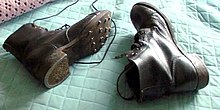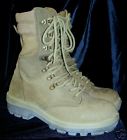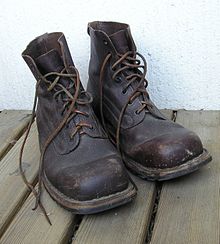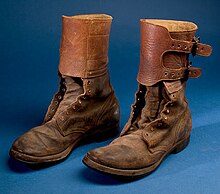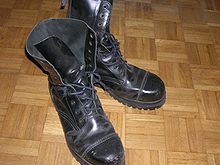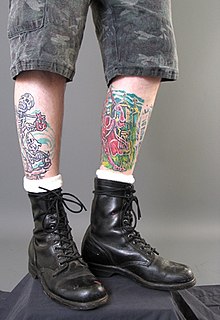Combat Boots Fashion
Combat boots are military boots designed to be worn by soldiers during actual combat or combat training as opposed to during parades and other ceremonial duties. Modern combat boots are designed to provide a combination of grip, ankle stability, and foot protection suitable to a rugged environment. They are traditionally made of hardened, sometimes waterproofed leather. Today, many combat boots incorporate many technologies originating in civilian hiking boots, such as Gore-Tex nylon side panels, which improve ventilation and comfort.[1] They are also often specialized for certain climates and conditions, such as jungle boots, desert boots, and cold weather boots as well as specific uses, such as tanker boots and jump boots.[1][2][3]
During the English Civil War each soldier of the New Model Army was issued three shoes or ankle boots. After every march the soldier would change them round to ensure they received even wear. Following the Restoration shoes and uniforms followed the civilian pattern: shoes with buckles were used by most armies from 1660 until around 1800. Hessian boots were used by cavalry from the 18th century until World War I.
Late in the Napoleonic Wars the British army began to be issued lace-up ankle boots that replaced the older buckle shoes. These "Blucher" boots remained in use throughout the 19th century and were used in conflicts that included the Crimean War (1853-1856), First Zulu War (1879), and First Boer War (1880-1881).
These in turn were replaced by ammunition boots which were used in a variety of similar patterns from the late 1880s until the late 1960s. The "George Boots" worn with the Officers' dress uniform and mess dress are similar, except they lack the leather counter (heel cap) and toe case (toe-cap) and omit the hobnails and steel heel- and toe-plates.
Rifle units of the US military were equipped with calf-high boots in the War of 1812.[4] From the 1820s until before the American Civil War soldiers were issued ankle-high boots which were made on straight lasts. There was no "left" or "right" boot: instead they shaped themselves to the wearer's feet over time. Needless to say, until they were broken in, these boots were very uncomfortable and often resulted in blisters. These were replaced in 1858 with an improved version used until the 1880s, known as Jeff Davis boots after Jefferson Davis, the Secretary of War who re-equipped the army in the 1850s.
Combat boots are military boots designed to be worn by soldiers during actual combat or combat training as opposed to during parades and other ceremonial duties. Modern combat boots are designed to provide a combination of grip, ankle stability, and foot protection suitable to a rugged environment. They are traditionally made of hardened, sometimes waterproofed leather. Today, many combat boots incorporate many technologies originating in civilian hiking boots, such as Gore-Tex nylon side panels, which improve ventilation and comfort.[1] They are also often specialized for certain climates and conditions, such as jungle boots, desert boots, and cold weather boots as well as specific uses, such as tanker boots and jump boots.[1][2][3]
During the English Civil War each soldier of the New Model Army was issued three shoes or ankle boots. After every march the soldier would change them round to ensure they received even wear. Following the Restoration shoes and uniforms followed the civilian pattern: shoes with buckles were used by most armies from 1660 until around 1800. Hessian boots were used by cavalry from the 18th century until World War I.
Late in the Napoleonic Wars the British army began to be issued lace-up ankle boots that replaced the older buckle shoes. These "Blucher" boots remained in use throughout the 19th century and were used in conflicts that included the Crimean War (1853-1856), First Zulu War (1879), and First Boer War (1880-1881).
These in turn were replaced by ammunition boots which were used in a variety of similar patterns from the late 1880s until the late 1960s. The "George Boots" worn with the Officers' dress uniform and mess dress are similar, except they lack the leather counter (heel cap) and toe case (toe-cap) and omit the hobnails and steel heel- and toe-plates.
Rifle units of the US military were equipped with calf-high boots in the War of 1812.[4] From the 1820s until before the American Civil War soldiers were issued ankle-high boots which were made on straight lasts. There was no "left" or "right" boot: instead they shaped themselves to the wearer's feet over time. Needless to say, until they were broken in, these boots were very uncomfortable and often resulted in blisters. These were replaced in 1858 with an improved version used until the 1880s, known as Jeff Davis boots after Jefferson Davis, the Secretary of War who re-equipped the army in the 1850s.
Combat Boots Fashion
Combat Boots Fashion
Combat Boots Fashion
Combat Boots Fashion
Combat Boots Fashion
Combat Boots Fashion
Combat Boots Fashion
Combat Boots Fashion
Combat Boots Fashion
Combat Boots Fashion
Combat Boots Fashion
Combat Boots Fashion
Combat Boots Fashion
Combat Boots Fashion
Combat Boots Fashion
Combat Boots Fashion
Combat Boots Fashion
Combat Boots Fashion
Combat Boots Fashion
Combat Boots Fashion


